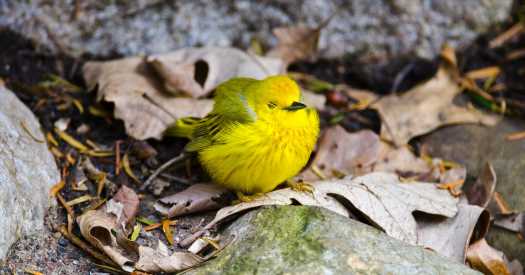Every spring, throngs of garden warblers make a treacherous, multiweek journey from their winter homes in Africa to their summer breeding grounds in Europe.
The small, brown-and-white songbirds fly thousands of miles, across the Sahara and the Mediterranean Sea, en route to their destinations. It’s an exhausting, arduous trip, and the warblers make numerous pit stops to rest and refuel along the way. During these layovers, the birds need to catch up on sleep, replenish their fat stores, and somehow manage to avoid being eaten by predators, including the hungry raptors that migrate alongside them.
A study published on Monday in Current Biology revealed one way that migrating warblers manage these dangers and demands: They adjust their sleep postures depending on their physical condition and physiological needs. Plump, well-muscled birds tend to sleep with their heads held upright, while scrawnier warblers tuck their heads into their feathers, a posture that makes them more vulnerable to predation but helps them conserve their much needed energy.
“Migratory warblers have to make trade-offs between staying safe and saving energy,” said Leonida Fusani, a behavioral physiologist at the University of Vienna and the lead author of the paper.
Dr. Fusani worked with a doctoral student, Andrea Ferretti, and several other colleagues to study garden warblers that had stopped on the island of Ponza during their spring migration. The small, craggy isle, off the western coast of Italy, is a popular stopover for northbound birds, which typically arrive drained after a 300-plus-mile flight over open water.
[Like the Science Times page on Facebook. | Sign up for the Science Times newsletter.]
The researchers caught warblers with nets, then gave each one a brief physical exam before transferring it to a custom-built cage for observation. Some of the warblers were thriving, with heavy bodies, big muscles and ample body fat. Others seemed to be struggling, appearing gaunt and worn down by their journeys.
Birds in good condition slept more during the day than those in poor condition, the scientists found, perhaps because those birds didn’t need to spend as much time foraging for food. And at night, the robust birds generally slept facing forward, with their heads erect. The leaner birds, on the other hand, literally tucked themselves in at night, swiveling their heads around and nestling them under the feathers on their shoulders.
Dr. Fusani, Mr. Ferretti and their colleagues conducted several follow-up studies to try to make sense of this pattern. In one, they used a thermal-imaging camera to monitor the body temperature of warblers sleeping in the untucked position. These birds lost heat primarily through their heads, especially from the area around their eyes. By tucking their heads into their feathers, skinny warblers may be able to minimize this heat loss, the researchers said.
Additionally, when the scientists placed the birds in a respirometry chamber overnight, they discovered that warblers sleeping in the tucked position had lower metabolic rates than those that slept untucked.
Together, the findings suggest that migrating birds that arrive at their stopovers in poor condition may adjust by selecting a sleeping posture that preserves their dwindling supply of energy.
“Evolution has created these behavioral flexibilities that allow birds to compensate if they have to use more fat stores on this leg because they ran into a storm or it got colder than they anticipated,” said Scott McWilliams, who studies avian ecology and physiology at the University of Rhode Island, and is an author of the paper.
But if the tucked position has such benefits, why don’t all the warblers use it? Dr. Fusani and his colleagues speculated that the posture might make birds less alert to potential threats. To test this theory, they simulated the sound of an approaching predator by playing a recording of crunching leaves as the warblers slept. Sure enough, birds in the tucked position took longer to respond than those that snoozed with their heads facing forward. “The cost of sleeping tucked in is a slower reaction time,” Mr. Ferretti said.
The research could help shed new light on the general benefits and function of sleep, the scientists said, as well as how migrating animals can harness it to boost their odds of survival.
“We never suspected that sleep pattern was an important factor in migratory strategy,” Dr. Fusani said.
Source: Read Full Article




